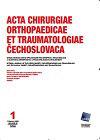Biomechanical Comparison of the Roof Step Cut Technique with the Bulk Bone Graft Technique During Total Hip Arthroplasty for Hip Dysplasia: a Finite Element Analysis.
IF 0.4
4区 医学
Q4 ORTHOPEDICS
Acta chirurgiae orthopaedicae et traumatologiae Cechoslovaca
Pub Date : 2023-11-11
DOI:10.55095/achot2023/036
引用次数: 0
Abstract
PURPOSE OF THE STUDY Different techniques have been reported to reconstruct the defi cient acetabulum during total hip arthroplasty (THA). The purpose of this study was to compare the biomechanical features of the bulk bone graft (BBG) technique (Harris acetabular plasty) and the Roof Step Cut (RSC) technique using fi nite element analysis. MATERIAL AND METHODS Based on a female patient's dysplastic hip CT scan, 3D models were assembled according to the two techniques. For the Harris technique, an irregular BBG was sculpted from a solid sphere, while for the RSC technique, the graft was sculpted into a step-cut shape with a similar size. Each graft was fi xed with two compression screws at two different angles (0° and 45°). Four fi nite element models were used to compare the von Mises stress distribution and total deformation of the grafts and the screws. The pressure and sliding distances of the contacts between the bone graft, metal cup and acetabular host bone were also analyzed. RESULTS For both of the bone grafts and the screws, compared to the Harris models, the maximum stress of the RSC models was signifi cantly lower (16.56 MPa, 25.50 MPa vs 97.13 MPa, 112.72 MPa) and the total deformation was signifi cantly smaller (0.0096 mm, 0.0089 mm vs 0.022 mm, 0.018 mm). 45° inserted screws generated higher stress at the end of the screws and on the outside of the bone graft. In case of 0° inserted screws, the maximum value was mainly located in the middle of the screws, inside the screw channel as well as at the contact area between the graft and the host bone. At all analyzed contacts, the RSC technique shows signifi cantly lower pressure and sliding distances, irrelevant to the screw's insertion angle. In comparison, the model of BBG with 45° screws showed a signifi cant sliding effect and higher contact pressure. CONCLUSIONS Compared with the BBG technique, the step-shaped graft of the RSC technique could signifi cantly reduce the maximum stress and deformation of the graft and the screws, and decrease the pressure and sliding distance between the bone graft, metal cup and the acetabular host bone. The angle of screw placement affects the location of stress and deformation. Key words: developmental dysplasia of the hip, total hip arthroplasty, acetabular reconstruction, bone graft, fi nite element analysis.髋关节发育不良全髋关节置换术中屋顶阶梯切割技术与大块骨移植技术的生物力学比较:有限元分析。
研究目的 据报道,在全髋关节置换术(THA)中,有不同的技术用于重建有缺陷的髋臼。本研究的目的是通过有限元分析,比较大块骨移植(BBG)技术(Harris 髋臼成形术)和屋顶阶梯切割(RSC)技术的生物力学特征。材料和方法 根据一名女性患者发育不良的髋关节 CT 扫描结果,按照两种技术组装了三维模型。在 Harris 技术中,不规则的 BBG 由实体球体雕刻而成,而在 RSC 技术中,移植物被雕刻成大小相似的阶梯切割形状。每个移植物用两个不同角度(0° 和 45°)的压缩螺钉固定。使用四个有限元模型比较了移植物和螺钉的 von Mises 应力分布和总变形。此外,还分析了植骨、金属杯和髋臼主骨之间接触的压力和滑动距离。结果 对于移植物骨和螺钉,与 Harris 模型相比,RSC 模型的最大应力明显较低(16.56 兆帕、25.50 兆帕 vs 97.13 兆帕、112.72 兆帕),总变形明显较小(0.0096 毫米、0.0089 毫米 vs 0.022 毫米、0.018 毫米)。45° 插入螺钉在螺钉末端和植骨外侧产生的应力较大。而 0° 插入螺钉的最大值主要位于螺钉中部、螺钉通道内部以及植骨与主骨的接触区域。在所有分析的接触点上,RSC 技术都显示出明显较低的压力和滑动距离,这与螺钉的插入角度无关。相比之下,使用 45° 螺钉的 BBG 模型显示出明显的滑动效应和较高的接触压力。结论 与 BBG 技术相比,RSC 技术的阶梯状植骨可显著降低植骨和螺钉的最大应力和变形,并减少植骨、金属杯和髋臼宿主骨之间的压力和滑动距离。螺钉放置的角度会影响应力和变形的位置。关键词:髋关节发育不良、全髋关节置换术、髋臼重建、植骨、有限元分析。
本文章由计算机程序翻译,如有差异,请以英文原文为准。
求助全文
约1分钟内获得全文
求助全文
来源期刊
CiteScore
0.70
自引率
25.00%
发文量
53
期刊介绍:
Editorial Board accepts for publication articles, reports from congresses, fellowships, book reviews, reports concerning activities of orthopaedic and other relating specialised societies, reports on anniversaries of outstanding personalities in orthopaedics and announcements of congresses and symposia being prepared. Articles include original papers, case reports and current concepts reviews and recently also instructional lectures.

 求助内容:
求助内容: 应助结果提醒方式:
应助结果提醒方式:


